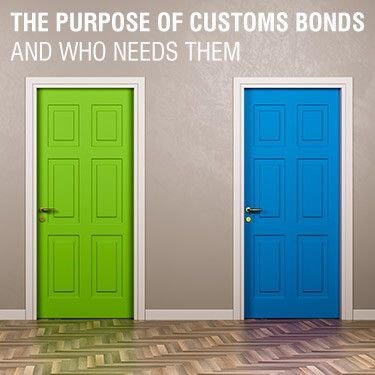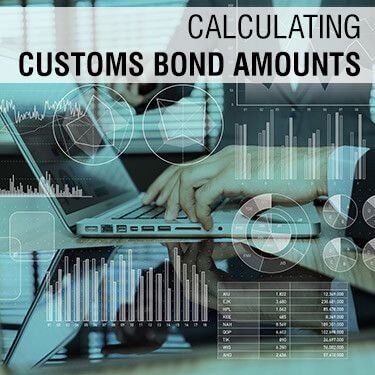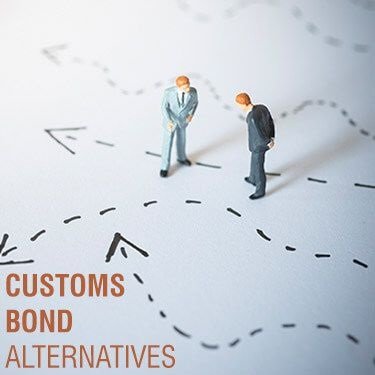Application for Us Custom Continuous Import Bond
As you prepare to import goods, calculating customs bond amounts can appear to be a roadblock in unfamiliar territory. Customs bonds are a frequent topic of confusion in the importing community. Not to be confused with a temporary import bond (TIB) or a shipment moving "in bond", which are types of shipments. The posting of a customs bond is a government requirement for most companies that import goods into the United States. Here, we will try to demystify bonds and how calculating customs bond amounts is handled. First, the type of bond will determine the calculation used. For example, a continuous bond requires 10% based on the duties, taxes and fees paid in the previous year. Also, certain products that are subject to government restrictions are calculated differently. There are additional factors used when calculating customs bond amounts. We will cover: The many variables of importing freight must be addressed on a case by case basis for calculating customs bond amounts. Whether the commodity is regulated, requires special handling or is a hazardous material can alter the conditions of a bond. In addition, the point of origin or the destination may require the surety company to make bond modifications too. USA Customs Clearance is here to help answer the questions you have regarding calculating custom bond amounts on importing goods into the United States. Table Of Contents A customs bond is a type of surety bond. Surety bonds are similar to insurance policies in that they protect the entity that is requiring the bond. Commercial goods valued at more than $2,500 must have a customs bond to clear a U.S. port of entry. In addition, any commodity being imported with federal regulations must also have a customs bond. Importers are often required to pay duties, taxes, and fees to the United States Customs and Border Protection (CBP). By having a customs bond in place it ensures importers will not default on these fees. It is a legal document. Customs Bonds are required for: Before we move on, it's important to understand the different types of bonds and what each can mean when calculating customs bond amounts. Customs bonds are generally divided into two types: Both of these distinctions impact the bond required and how calculating customs bond amounts is performed. While a single entry bond is just that, covers the arrival of one shipment, a continuous bond is in place for all shipments during a specified period of time. Some bond type needs to be renewed periodically, typically once per year, while others renew automatically. The duration of a bond impacts the amount calculation and the cost. A continuous bond benefits importers that have a lot of shipments. Importers with only a couple of shipments each year should evaluate both options. In many cases, a continuous bond may better serve a frequent shipper. The costs of several single entry bonds or single transaction bonds add up quickly. There is also extra administrative work when you have a single bond for every import. Not sure whether or not you need a customs bond? Check out our article What Does a Customs Bond Cover? Make Sure You Have The Right Customs Bond Get your continuous customs bond today This article is primarily focused on customs bonds for importers. But any company that is handling imports must have a customs bond. Carriers and warehouses are two types of companies that importers work with. They each must have their own customs bond. This includes international carriers that transport cargo. It also means domestic carriers that wish to move cargo "in-bond" must have a bond. As do warehouses that wish to operate as a bonded facility to store imported goods. Importers must have a customs bond for general merchandise over $2,500. There are other situations where importers may have other bond requirements. This also affects calculating the customs bond amount. Any goods subject to restrictions by other government agencies, also known as OGAs, will require calculating a customs bond amount that is different from general merchandise. The additional agencies with federal jurisdiction include: Depending on the freight commodity, importers or their designee will need to know the guidelines established by each agency for regulated goods. Ocean imports must have an ISF Filing. ISF stands for Importer Security Filing and contains numerous requirements that importers must adhere to. Importers must get an ISF Bond and are subject to fines if the ISF is not filed correctly. These goods require calculating a customs bond amount that is different from general merchandise. An import quota refers to how much of a commodity can enter the US. Some of the commodities include: The CBP outlines a full list of commodities subject to import quotas. Work with a specialist to make importing and exporting to the USA a hassle-free process. Get the details you need with our import consulting services. Goods imported into the United States and then either re-exported or destroyed are subject to duties that can be reclaimed. In this case an importer would need a drawback bond. It is important to note that a drawback bond can be advantageous for an importer who can document that they imported freight which was then exported out of the country. This type of bond would also cover if the goods were imported and then destroyed. In both situations, an importer with a drawback bond can claim up to 99% of the duties paid on the shipment. Occurs when the Department of Commerce determines that imported goods are being sold below market value. ADD/CVD requires calculating a customs bond amount that is different from general merchandise. When it comes to shipping anything whether moving domestically or a foreign import, it must have a bill of lading or a BOL attached. The document is required by law and is intended to be a receipt of the goods being shipped. The Bill of Lading includes: Understand that if a shipper fails to attach a bill of lading, the freight will be flagged at the port and not granted release. This means the shipment will be delayed to final delivery and there are now other penalties and fees involved. Once calculating customs bond amounts is done, the information is also listed on the BOL. In case a problem arises and the conditions of the bond are not met, the maximum payout amount for the penalty is listed. Most amounts are listed as a percentage of the value of the freight and also includes the duties, taxes and other fees of the previous year. So it's up to the importer to make sure all information is correct, and no corners were cut because it could cost more in the long run. The amount of a customs bond is like the coverage amount of an insurance policy. But it is not insurance. Any claim the government makes against an importer is still the responsibility of the importer to pay. If the importer can't actually cover the payment, the surety company is then responsible. The bond is protection for the government when the terms of the bond contract are not met. It is a way to ensure payment is received for any duties, taxes and fees owed at the port of entry. The CBP also sets the amounts for customs bonds. CBP Directive 099 3510-004 outlines the method for calculation. Make Sure You Have The Right Customs Bond Get your continuous customs bond today How calculations are done: The importer needs to have a good understanding of the freight they are intending to ship. Whether it's a regulated commodity or is of high value is an important variable in the calculation process. These details will be critical when working with a broker who will need to secure the best customs bond. When calculating customs bond amounts it matters that all of the information about the freight is correct and nothing has been overlooked. This is where a customs broker can assist importers to make sure all details are in place. Since the value of a one-time freight shipment or the total of freight shipped during a calendar year by an importer is used to calculate customs bond amounts, the numbers need to be right. Otherwise, importers could be faced with a penal sum which is, in fact, a penalty. It's already a costly investment to import goods, why run the tab up even more with unnecessary costs? It matters if the cost of the freight is listed incorrectly on the BOL. If the conditions of the bond are not met other fees are piled on, it could mean even more if the freight values and the size or quantity of the shipment is inaccurate. Want to make sure your commercial imports are prepared properly for Customs clearance? Check out our article Importing Depends on the U.S. Customs Bond Verification Process. Importers can get a customs bond either directly from a licensed Surety or through a licensed customs broker. Although customs bonds are in place to protect the government, CBP only works with specific surety companies. A list of licensed sureties is maintained by the Bureau of the Fiscal Service. Customs brokers can be agents of sureties and also sell customs bonds. Customs brokers will also: The premium is the amount the importer pays for a bond. The premium amount is dependent on the surety or customs broker. A premium often includes a minimum amount to cover the processing work done by the surety. Some customs brokers will charge a flat fee for the bond, which is most common with continuous bonds. Customs brokers may calculate the premium as a percentage of the bond amount. They may also assess the creditworthiness of the importer and factor it into the rate. The process and costs of obtaining import bonds can be daunting for new importers. There is an alternative option that the CBP allows called "cash-in-lieu-of surety bond option." This option requires the importer to post cash collateral for the face value of the bond. This option protects the government because the importer is guaranteeing their payment with their own cash. The benefit is that the importer does not need to pay a premium to a Surety or Customs Broker. However, the importer's working capital is not readily available. In the case of an importer continuously importing goods, their working capital may, therefore, be tied up permanently. The cash outlay can be determined by calculating the customs bond amount. The opportunity cost of the cash outlay can then be compared to the bond premium. In most cases, the savings on the premium do not justify the cost of the capital being posted. Also, many businesses cannot have their capital tied up for long periods of time irrespective of any financial benefits. In most cases, importers will need a customs bond. They may also be subject to bond requirements from OGAs or for other activities. Customs brokers can help importers understand their specific bond requirements. They can also assist in calculating customs bond amounts and premiums. While there are alternative options to obtaining a bond, for most companies the cash outlay requirements do not justify the relatively small savings. When it comes to calculating customs bond amounts, USA Customs Clearance and our team of licensed customs bond brokers are ready to help importers calculate customs bond amounts. The broker can work with you to find the right bond for your freight, assist with filling out the application and ensure guidelines are followed as required. Our easy 3-Step process takes away the hard work on your part. In addition, USA Customs Clearance is able to connect clients with one of our expert consultants to answer in-depth questions about a particular import commodity or the overall process with a freight load. This low-cost option may help clear up a list of questions and help importers understand the entire process from start to finish. Whether importing toys from China, importing exotic hardwood flooring or another commodity, importers will work closely with a professional broker who will educate them on everything that is covered by a customs bond and how the cost is determined. We realize calculating customs bond amounts can be a stressful part of the entire process. The team at USA Customs Clearance can answer your questions and work on your behalf to get the job done.
The Purpose of Customs Bonds and Who Needs Them

Bond Type by Activity for Service Companies

Bond Type by Activity for Importers
Other Government Agency (OGA) requirements
Importer Security Filing (ISF) Bonds
Goods subject to quota and/or visa requirements
Drawback Bonds
Antidumping (ADD) / Countervailing Duty (CVD)
Bond Amount Listed on the BOL
Calculating Customs Bond Amounts

Why Calculating Customs Bond Amounts Matter
How to Obtain a Customs Bond and Handling the Cost
Customs Bond Alternatives

Connect with the Pros
Source: https://usacustomsclearance.com/process/calculating-customs-bond-amounts-what-you-need-to-know/